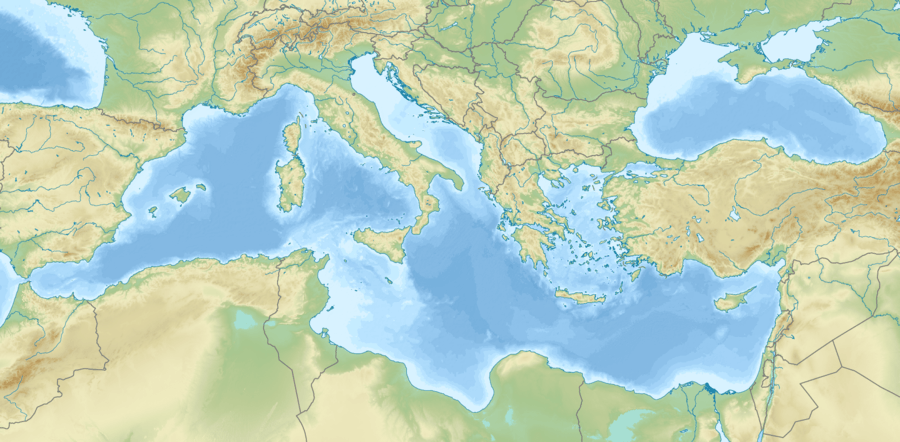Aurignacian
The Aurignacian (/ɔːrɪɡˈneɪʃən/) is an archaeological tradition of the Upper Palaeolithic associated with European early modern humans (EEMH) lasting from 43,000 to 26,000 years ago. The Upper Paleolithic developed in Europe some time after the Levant, where the Emiran period and the Ahmarian period form the first periods of the Upper Paleolithic, corresponding to the first stages of the expansion of Homo sapiens out of Africa.[4] They then migrated to Europe and created the first European culture of modern humans, the Aurignacian.[5]
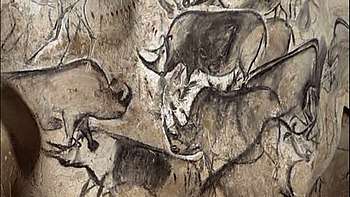 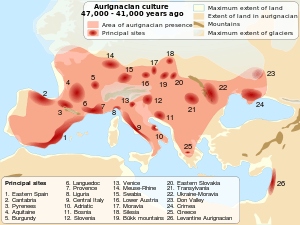 Rhino drawings from the Chauvet Cave, 37,000 to 33,500 years old, and map of Aurignacian sites | |
| Geographical range | Eurasia |
|---|---|
| Period | Upper Paleolithic |
| Dates | c. 43,000 – c. 28,000 BP[1][2] |
| Type site | Aurignac |
| Preceded by | Ahmarian, Châtelperronian |
| Followed by | Gravettian |
| Defined by | Breuil and Cartailhac, 1906[3] |
An Early Aurignacian or Proto-Aurignacian stage is dated between about 43,000 and 37,000 years ago. The Aurignacian proper lasts from about 37,000 to 33,000 years ago. A Late Aurignacian phase transitional with the Gravettian dates to about 33,000 to 26,000 years ago.[6][5] The type site is the Cave of Aurignac, Haute-Garonne, south-west France. The main preceding period is the Mousterian of the Neanderthals.
One of the oldest examples of figurative art, the Venus of Hohle Fels, comes from the Aurignacian and is dated to between 40,000 and 35,000 years ago (though now earlier figurative art may be known, see Lubang Jeriji Saléh). It was discovered in September 2008 in a cave at Schelklingen in Baden-Württemberg in western Germany. The German Lion-man figure is given a similar date range. The Bacho Kiro site in Bulgaria is one of the earliest known Aurignacian burials.[7]
A "Levantine Aurignacian" culture is known from the Levant, with a type of blade technology very similar to the European Aurignacian, following chronologically the Emiran and Early Ahmarian in the same area of the Near East, and also closely related to them.[8] The Levantine Aurignacian may have preceded European Aurignacian, but there is a possibility that the Levantine Aurignacian was rather the result of reverse influence from the European Aurignacian: this remains unsettled.[9]
Main characteristics

The Aurignacians are part of the wave of anatomically modern humans thought to have spread from Africa through the Near East into Paleolithic Europe, and became known as European early modern humans, or Cro-Magnons.[4] This wave of anatomically modern humans includes fossils of the Ahmarian, Bohunician, Aurignacian, Gravettian, Solutrean and Magdalenian cultures, extending throughout the Last Glacial Maximum (LGM), covering the period of roughly 48,000 to 15,000 years ago.[4]
The Aurignacian tool industry is characterized by worked bone or antler points with grooves cut in the bottom. Their flint tools include fine blades and bladelets struck from prepared cores rather than using crude flakes.[10] The people of this culture also produced some of the earliest known cave art, such as the animal engravings at Trois Freres and the paintings at Chauvet cave in southern France. They also made pendants, bracelets, and ivory beads, as well as three-dimensional figurines. Perforated rods, thought to be spear throwers or shaft wrenches, also are found at their sites.
Association with modern humans
.png)
The sophistication and self-awareness demonstrated in the work led archaeologists to consider the makers of Aurignacian artifacts the first modern humans in Europe. Human remains and Late Aurignacian artifacts found in juxtaposition support this inference. Although finds of human skeletal remains in direct association with Proto-Aurignacian technologies are scarce in Europe, the few available are also probably modern human. The best dated association between Aurignacian industries and human remains are those of at least five individuals from the Mladeč caves in the Czech Republic, dated by direct radiocarbon measurements of the skeletal remains to at least 31,000–32,000 years old. At least three robust, but typically anatomically-modern individuals from the Peștera cu Oase cave in Romania, were dated directly from the bones to ca. 35,000–36,000 BP. Although not associated directly with archaeological material, these finds are within the chronological and geographical range of the Early Aurignacian in southeastern Europe.[10] On genetic evidence it has been argued that both Aurignacian and the Dabba culture of North Africa came from an earlier big game hunting Levantine Aurignacian culture of the Levant.[11]
Art

Aurignacian figurines have been found depicting faunal representations of the time period associated with now-extinct mammals, including mammoths, rhinoceros, and tarpan, along with anthropomorphized depictions that may be interpreted as some of the earliest evidence of religion.
Many 35,000-year-old animal figurines were discovered in the Vogelherd Cave in Germany.[12] One of the horses, amongst six tiny mammoth and horse ivory figures found previously at Vogelherd, was sculpted as skillfully as any piece found throughout the Upper Paleolithic. The production of ivory beads for body ornamentation was also important during the Aurignacian. The famous paintings in Chauvet cave date from this period.
Typical statuettes consist of women that are called Venus figurines. They emphasize the hips, breasts, and other body parts associated with fertility. Feet and arms are lacking or minimized. One of the most ancient figurines was discovered in 2008 in the Hohle Fels cave in Germany. The figurine has been dated to 35,000 years ago.[13][14]
Aurignacian finds include bone flutes. The oldest undisputed musical instrument was the Hohle Fels Flute discovered in the Hohle Fels cave in Germany's Swabian Alb in 2008.[15] The flute is made from a vulture's wing bone perforated with five finger holes, and dates to approximately 35,000 years ago.[15] A flute was also found at the Abri Blanchard in southwestern France.[16]
 Löwenmensch figurine, found in the Hohlenstein-Stadel cave of Germany's Swabian Alb and dated at 40,000 years old, is associated with the Aurignacian culture and is the oldest known anthropomorphic animal figurine in the world
Löwenmensch figurine, found in the Hohlenstein-Stadel cave of Germany's Swabian Alb and dated at 40,000 years old, is associated with the Aurignacian culture and is the oldest known anthropomorphic animal figurine in the world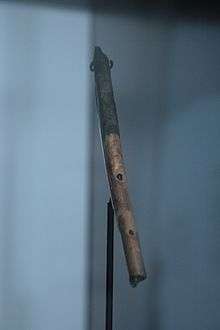 Bone flute, one of the oldest known musical instruments (age: 35.000 - 40.000 year old) Landesmuseum Württemberg)
Bone flute, one of the oldest known musical instruments (age: 35.000 - 40.000 year old) Landesmuseum Württemberg)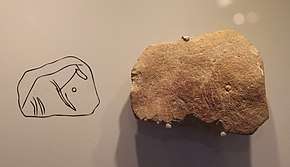 Carving of a running horse, Hayonim Cave, Levant.
Carving of a running horse, Hayonim Cave, Levant. Jewelry, Fazael, Israel, Upper Paleolithic.
Jewelry, Fazael, Israel, Upper Paleolithic. Painting of a hand. Cave of Aurignac.
Painting of a hand. Cave of Aurignac.
Tools
Stone tools from the Aurignacian culture are known as Mode 4, characterized by blades (rather than flakes, typical of mode 2 Acheulean and mode 3 Mousterian) from prepared cores. Also seen throughout the Upper Paleolithic is a greater degree of tool standardization and the use of bone and antler for tools. Based on the research of scraper reduction and paleoenvironment, the early Aurignacian group moved seasonally over greater distances to procure reindeer herds within cold and open environments than those of the earlier tool cultures.[18]
 Bone point
Bone point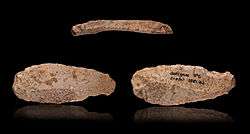
 Aurignacian blades
Aurignacian blades.jpg) Dufour bladelet
Dufour bladelet Aurignacian Culture incised animal bones, Hayonim Cave, Levant, 28000 BP.
Aurignacian Culture incised animal bones, Hayonim Cave, Levant, 28000 BP.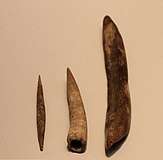 Aurignacian Culture bone tools (needdle, points and tools for punching holes), Hayonim Cave, 30000 BP.
Aurignacian Culture bone tools (needdle, points and tools for punching holes), Hayonim Cave, 30000 BP..jpg) Mousterian & Aurignacian Cultures, stone burins used for incising stone and wood, Qafzeh, Hayonim, el-Wad Cave, 250,000-22,000 BP Israel
Mousterian & Aurignacian Cultures, stone burins used for incising stone and wood, Qafzeh, Hayonim, el-Wad Cave, 250,000-22,000 BP Israel Aurignacian microliths
Aurignacian microliths
Location
| The Paleolithic |
|---|
| ↑ Pliocene (before Homo) |
|
|
|
|
Fertile Crescent:
|
| ↓ Mesolithic |
Asia
Lebanon/Palestine/Israel region
- Contained within a stratigraphic column, along with other cultures.[19]
- Many sites in Siberia including around Lake Baikal, the Ob River valley, and Minusinsk.[19]
Genetics
In a genetic study published in Nature in May 2016, the remains of an Aurignacian individual from modern-day Belgium were examined. He belonged to the paternal haplogroup C1a and the maternal haplogroup M.[20]
References
- Milisauskas, Sarunas (2012-12-06). European Prehistory: A Survey. ISBN 9781461507512.
- Shea, John J. (2013-02-28). Stone Tools in the Paleolithic and Neolithic Near East: A Guide. ISBN 9781139619387.
- H. Martin (1906). "Industrie Moustérienne perfectionnée. Station de La Quina (Charente)". Bulletin de la Société Préhistorique de France (in French). 3 (6): 233–239. doi:10.3406/bspf.1906.7784. JSTOR 27906750.(subscription required)
- Klein, Richard G. (2009). The Human Career: Human Biological and Cultural Origins. University of Chicago Press. p. 610. ISBN 9780226027524.
- Wood, Bernard, ed. (2011). "Aurignacian". Wiley-Blackwell Encyclopedia of Human Evolution, 2 Volume Set. Wiley-Blackwell Encyclopedia of Human Evolution. John Wiley. ISBN 9781444342475.
- Hoffecker, JF (September 2009). "Out of Africa: modern human origins special feature: the spread of modern humans in Europe". Proc. Natl. Acad. Sci. U.S.A. 106: 16040–5. Bibcode:2009PNAS..10616040H. doi:10.1073/pnas.0903446106. PMC 2752585. PMID 19571003.. Jacobi, R.M.; Higham, T.F.G.; Haesaerts, P.; Jadin, I.; Basell, L.S. (2010). "Radiocarbon chronology for the Early Gravettian of northern Europe: new AMS determinations for Maisières-Canal, Belgium". Antiquity. 84: 26–40. doi:10.1017/S0003598X00099749.
- Milisauskas, Sarunas (2011). European Prehistory: A Survey. Springer. p. 74. ISBN 978-1-4419-6633-9. Retrieved 8 June 2012.
One of the earliest dates for an Aurignacian assemblage is greater than 43,000 BP from Bacho Kiro cave in Bulgaria ...
- Shea, John J. (2013). Stone Tools in the Paleolithic and Neolithic Near East: A Guide. Cambridge University Press. pp. 150–155. ISBN 9781107006980.
- Williams, John K. (2006). "The Levantine Aurignacian: a closer look" (PDF). Lisbon: Instituto Português de Arqueologia (Trabalhos de Arqueologia Bar-Yosef O, Zilhão J, Editors. Towards a Definition of the Aurignacian. 45): 317–352.
- Mellars, P. (2006). "Archeology and the Dispersal of Modern Humans in Europe: Deconstructing the Aurignacian". Evolutionary Anthropology. 15: 167–182. doi:10.1002/evan.20103.
- Forster, P.; Romano, V.; Olivieri, A.; Achilli, A.; Pala, M.; Battaglia, V.; Fornarino, S.; Al-Zahery, N.; Scozzari, R.; Cruciani, F.; Behar, D. M.; Dugoujon, J.-M.; Coudray, C.; Santachiara-Benerecetti, A. S.; Semino, O.; Bandelt, H.-J.; Torroni, A. (2007). "Timing of a Back-Migration into Africa". Science. 316: 50–53. doi:10.1126/science.316.5821.50., "Sequencing of 81 entire human mitochondrial DNAs (mtDNAs) belonging to haplogroups M1 and U6 reveals that these predominantly North African clades arose in southwestern Asia and moved together to Africa about 40,000 to 45,000 years ago. Their arrival temporally overlaps with the event(s) that led to the peopling of Europe by modern humans and was most likely the result of the same change in climate conditions that allowed humans to enter the Levant, opening the way to the colonization of both Europe and North Africa. Thus, the early Upper Palaeolithic population(s) carrying M1 and U6 did not return to Africa along the southern coastal route of the "out of Africa" exit, but from the Mediterranean area; and the North African Dabban and European Aurignacian industries derived from a common Levantine source."
- Finds from the Vogelherd cave Archived 2007-09-30 at the Wayback Machine
- Conard, Nicholas (2009). "A female figurine from the basal Aurignacian of Hohle Fels Cave in southwestern Germany". Nature. 459 (7244): 248–52. Bibcode:2009Natur.459..248C. doi:10.1038/nature07995. PMID 19444215.
- Henderson, Mark (2009-05-14). "Prehistoric female figure 'earliest piece of erotic art uncovered'". The Times. London.
- Conard, Nicholas; et al. (6 August 2009). "New flutes document the earliest musical tradition in southwestern Germany". Nature. 460 (7256): 737–740. Bibcode:2009Natur.460..737C. doi:10.1038/nature08169. PMID 19553935.
- Richard Leakey & Roger Lewin, Origins Reconsidered: In Search of What Makes Us Human (1992)
- Debeljak, Irena; Turk, Matija. "Potočka zijalka". In Šmid Hribar, Mateja; Torkar, Gregor; Golež, Mateja; et al. (eds.). Enciklopedija naravne in kulturne dediščine na Slovenskem – DEDI (in Slovenian). Archived from the original on 2012-05-15. Retrieved 12 March 2012.
- Blades, B (2003). "End scraper reduction and hunter-gatherer mobility". American Antiquity. 68: 141–156. doi:10.2307/3557037.
- Langer, William L., ed. (1972). An Encyclopedia of World History (5th ed.). Boston, MA: Houghton Mifflin Company. p. 9. ISBN 978-0-395-13592-1.
- Fu 2016.
Sources
- Fu, Qiaomei (May 2, 2016). "The genetic history of Ice Age Europe". Nature. Nature Research. 534 (7606): 200–205. Bibcode:2016Natur.534..200F. doi:10.1038/nature17993. hdl:10211.3/198594. PMC 4943878. PMID 27135931.CS1 maint: ref=harv (link)
External links
| Wikimedia Commons has media related to Aurignacian. |
- Picture Gallery of the Paleolithic (reconstructional palaeoethnology), Libor Balák at the Czech Academy of Sciences, the Institute of Archaeology in Brno, The Center for Paleolithic and Paleoethnological Research
